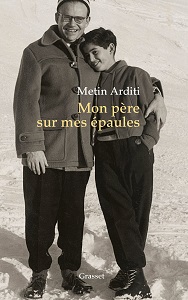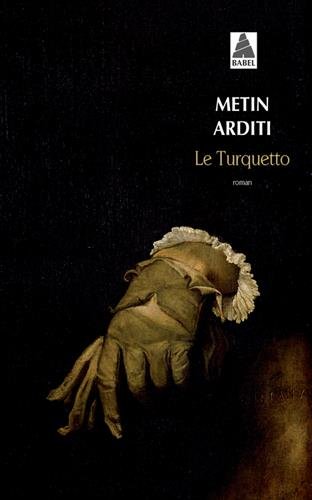Groupe de lecture : Metin Arditi, Le Turquetto
- IFE

- 1 avr. 2020
- 7 min de lecture
Mercredi dernier, le 25 mars, le groupe de lecture de la bibliothèque de l’Institut français d’Ecosse aurait dû se réunir pour une discussion autour du Turquetto, roman sans doute le plus connu de Metin Arditi. Les circonstances étant ce qu’elles sont, nous devrons reporter cette séance à plus tard.
Cependant, je me permets de proposer quelques notes de lecture pour entamer le débat. Le parcours de l’auteur tout d’abord attire l’attention: Metin Arditi est originaire de Turquie, mais il vit en Suisse depuis l’âge de 7 ans et a choisi le français comme langue d’écriture. Ce parcours individuel, certes porteur de richesses mais également douloureux l’a conduit à construire ses livres autour des thèmes de l’exil et de la rencontre entre les différentes cultures et religions.
Le Turquetto ne fait pas exception à la règle. Au cœur de l’intrigue : L’homme au gant, un portrait attribué au Titien et exposé au musée du Louvre. L’auteur précise dès l’abord, dans une note au lecteur, que la signature du tableau présente une anomalie chromatique qui a entrainé un certain nombre d’interrogations. Ce tableau ne serait pas l’œuvre du Titien ? Serait-il l’œuvre d’un de ses élèves, un peintre extrêmement talentueux que le Titien prénommait Le Turquetto, ou le petit Turc ? Si le Turquetto a existé, son œuvre ne se limiterait pas à un seul et unique tableau ?
Alors, Metin Arditi entame son récit… nous sommes en 1531 à Constantinople et nous suivons le parcours du jeune Elie Soriano né de parents juifs en terre musulmane. Avide de développer sa passion pour l’art, il fréquente, à l’insu de son entourage, les membres des communautés environnantes : Djelal, le fabricant d’encres, le pope Efthymios…
Et bien sûr, c’est Venise qui l’attire, le cœur de la Renaissance italienne, le rassemblement d’écoles prestigieuses. C’est aussi pour lui, la possibilité d’exprimer son art sans se heurter aux interdictions du Deutéronome (« Tu ne feras point d’images…de représentations des choses du ciel et de la terre…). Sous la direction de son maître, Le Titien, l’art du Turquetto atteint des sommets de perfection. Il apporte à la civilisation de la Renaissance sa formidable connaissance des textes bibliques et la tradition artistique byzantine. Quand son maître s’oriente vers une peinture plus « évanescente », leTurquetto se rapproche de la tradition de la calligraphie ottomane et recherche des contours nets. Son œuvre est de plus en plus « marquée par le disegno ».La soif de création s’accompagne d’une réflexion sur le pourquoi de l’art. La force d’Elie est d’avoir su peindre « l’humanité dans sa puissance et son espérance ».Plus tard, en repensant à son œuvre, « Il se souvint du sentiment qu’il avait eu, chaque fois, de vivre la condition humaine, d’être une partie d’elle. »
Autre question abordée : l’art et le pouvoir. Plus le Turquetto devient célèbre, plus il se rapproche des tenants du pouvoir. Il se retrouve au centre de luttes fratricides entre représentants des pouvoirs temporel et spirituel, entre les différentes écoles et les commanditaires. Pour avoir refusé de plier, il s’est brûlé les ailes.
Enfin, dernier aspect qui a attiré mon attention, la figure du père. Metin Arditi aborde souvent la question des difficultés de la filiation dans ses écrits. Ce regard du père est essentiel dans Le Turquetto ; en témoigne l’organisation même du récit. Le début du roman s’attarde sur le conflit larvé qui oppose Elie à son père : un homme malade, profondément diminué, exerçant une activité professionnelle réprouvée : assistant d’un marchand d’esclaves. Un homme qui ne comprend pas les aspirations de son fils. C’est l’exil qui permettra à Elie de s’accomplir. A la fin du roman, Elie est de retour à Constantinople. Il s’occupe du vieux mendiant et infirme Zeytine. Les gestes qu’il n’avait pas eu pour son père agonisant, il sait les trouver auprès du vieux Zeytine…et peu à peu, ses pensées le rapprochent à nouveau de son père, il trouve « l’humilité ».
J’ai souhaité en savoir un peu plus, je suis donc allée consulter un petit texte de Metin Arditi, paru en 2017 où il s’exprime douloureusement sur ses relations avec son père : Mon père sur mes épaules. C’est l’occasion pour l’auteur de revenir sur son enfance en Turquie, puis son placement en internat en Suisse dès l’âge de 7 ans. Il évoque avec beaucoup de tristesse l’absence des siens et le manque de reconnaissance de ce père souvent distant. Cette relation manquée est omniprésente dans ses romans : « J’ai mis dans mes romans autant de mon père que j’ai pu, de la même manière que j’utilise son stylo-plume, son porte-clés et sa montre ». A la fin du récit, Metin Arditi revient sur ce qu’il présente comme une forme de réconciliation avec son père, lorsque celui-ci lui avait souhaité pour ses 50 ans : « …plein de succès…Tout en restant un homme droit, intègre, et surtout humble. » Humble, comme le Turquetto à la fin de sa vie.
Last Wednesday, March 25, the reading group of the library of the French Institute in Scotland should have met to discuss the Turquetto, arguably the most well-known novel by Metin Arditi. Circumstances being what they are, we had to postpone this meeting.
However, I would like to offer a few reading notes to start the debate. The author’s career first attracts attention: Metin Arditi is originally from Turkey, but he has lived in Switzerland since the age of 7 and chose French as his language of writing. This individual journey, certainly rich but also painful, led him to build his books around the themes of exile and the encounter between different cultures and religions.
The Turquetto is no exception to the rule. At the heart of the plot: The man with the glove, a portrait attributed to Titian and exhibited at the Louvre Museum. The author first points out in a note to the reader that the signature of the painting presents a chromatic anomaly that has led to a number of interrogations. Would this painting actually not be the work of Titian? Could it be the work of one of his students, an extremely talented painter whom Titian named Le Turquetto, or the little Turk? If the Turquetto did exist, would his work not be limited to a single painting?
So, Metin Arditi begins his story... we are in 1531 in Constantinople and we follow the path of the young Elie Soriano born of Jewish parents in a Muslim land. Eager to develop his passion for art, he frequented, without the knowledge of his entourage, members of the surrounding communities: Djelal, the ink maker, the pope Efthymios...
And of course, it is Venice that attracts him, the heart of the Italian Renaissance, where prestigious schools are gathered. It is also for him, the possibility to express his art without running into the prohibitions of Deuteronomy ("You will not make images... representations of things from heaven and earth...). Under the direction of his master, Titian, the art of Turquetto reaches levels of perfection. He brings to Renaissance civilization his formidable knowledge of biblical texts and Byzantine artistic tradition. When his master turned to a more "evanescent" painting, the Turquetto approaches the tradition of Ottoman calligraphy and searches for clear contours. His work is increasingly "marked by the disegno." The thirst for creation is accompanied by a reflection on the meaning of art. Elijah’s strength is that he was able to paint "humanity in its power and hope." Later, reflecting on his work, "He remembered the feeling that he had, each time, of living the human condition, of being a part of it."
Another question raised in the book relates to art and power. The more famous the Turquetto becomes, the closer he becomes to the proponents of power. He finds himself at the centre of fratricidal struggles between representatives of temporal and spiritual powers, between different schools and sponsors. For refusing to bend, he burned his wings.
Finally, the last aspect that caught my attention is the figure of the father. Metin Arditi often addresses the difficulties of parentage in his writings. The father’s gaze is essential in Le Turquetto; evidenced by the very organisation of the story. The beginning of the novel dwells on the languishing conflict between Elijah and his father: a sick man deeply diminished, carrying out a condemned professional activity (slave trader’s assistant); a man who doesn’t understand his son’s aspirations. It is exile that will allow Elijah to fulfil his desires. At the end of the novel, Elijah is back in Constantinople and is taking care of the old beggar and crippled Zeytine. The gestures he did know how to use for his dying father, he knows how to find them with the old Zeytine ... and little by little, his thoughts eventually bring him closer to his father.
I wanted to know a little more, so I went to consult a little text by Metin Arditi, published in 2017 where he speaks painfully about his relationship with his father: Mon père sur mes épaules (My father on my shoulders). This is an opportunity for the author to look back on his childhood in Turkey, and on his placement in boarding school in Switzerland at the age of 7. He evokes with great sadness the absence of his family and the lack of recognition of this often distant father. This failed relationship is omnipresent in his novels: "I have put in my novels as much of my father as I could, in the same way that I use his fountain pen, his key ring and his watch." At the end of the story, Metin Arditi looks back on what he presents as a form of reconciliation with his father when he wished him for his 50th birthday "... lots of success... while remaining a good, honest, and above all humble man. » Humble, like the Turquetto at the end of his life.
© Article par Catherine Guiat pour le groupe de lecture.








Commentaires